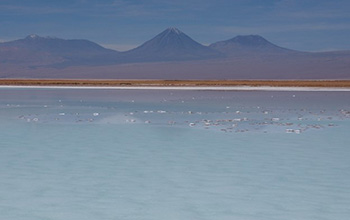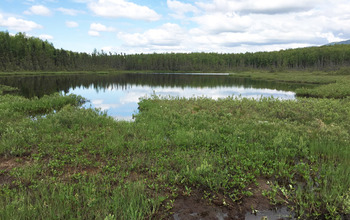搜索结果: 1-15 共查到“生物学 Earth”相关记录29条 . 查询时间(0.187 秒)

中国科学院地理科学与资源研究所牛书丽课题组在Nature Reviews Earth & Environment 上发表关于生态系统呼吸温度响应的综述(图)
牛书丽 生态系统 呼吸 群落
2024/8/8
生态系统呼吸(ER)是生物圈与大气之间最大的碳通量之一,研究ER的温度响应是准确预测未来大气CO2浓度以及气候变化的关键。目前陆面模型普遍认为ER随温度升高持续增加,甚至预测在本世纪末陆地生态系统呼吸所排放的CO2通量将超过光合作用吸收的CO2,从而使陆地生物圈从全球碳汇(净吸收)变成碳源(净排放)。然而近期的观测研究发现ER广泛存在最适温,即ER的温度响应是单峰型而非传统认知上的指数型,当温度超...


浙江师范大学生命科学学院倪健课题组在Earth System Science Data上发表重要研究成果(图)
倪健 Earth System Science Data 青藏高原 生态系统
2023/12/27


Zeroing in on the origins of Earth’s “single most important evolutionary innovation”(图)
地球 进化创新 含氧光合作用
2023/6/21
Selenium may support deep microbial life in Earth's continental crust
microbial earthcrust Se ecological system
2021/8/5
International drilling efforts over the last decades into the seafloor have provided increasing evidence for the existence of an extensive deep biosphere below the seafloor. There, circulating fluids ...

中国科学院西北生态环境资源研究院冰冻圈科学国家重点实验室康世昌团队及其合作者,基于MODIS(分辨率为500m×500m的中分辨率成像光谱仪)反照率数据,系统分析了2000-2018年青藏高原冰川表面反照率变化的时空分布;梳理了青藏高原冰川变化的资料(冰川末端退缩量以及物质平衡),探究了冰川表面反照率变化与冰川物质平衡的关系,并利用模型估算了反照率降低导致的冰川消融量,评估了冰川中黑碳对反照率降低...

Without oxygen, Earth's early microbes relied on arsenic to sustain life(图)
Without oxygen Earth early microbes relied arsenic sustain life
2020/10/16
Much of life on Earth today relies on oxygen to exist, but before oxygen was present on our planet, lifeforms likely used arsenic. The findings of the U.S. National Science Foundation-funded rese...

中国地质大学科学技术发展院刘小康(博士生),宋海军*等,地学院/BGEG国家重点实验室. Earth-Science Reviews (2020), Migration controls extinction and survival patterns of foraminifers during the Permian-Triassic crisis in South China(图)
孔虫;灭绝事件;深水迁移;幸存策略;海洋生物;重大环境;线索
2021/10/15
近日,中国地质大学地学院和生环国重2020级博士生刘小康为第一作者的研究论文“Migration controls extinction and survival patterns of foraminifers during the Permian-Triassic crisis in South China”在国际著名地学期刊《Earth-Science Reviews》上发表,通讯作者为宋海...
近日,中国科学院亚热带农业生态研究所环江喀斯特生态系统观测研究站王克林研究员团队在西南喀斯特地区植被恢复成效评估方面取得新进展,揭示了我国西南喀斯特地区植被恢复固碳效应的全球重要性,相关结果被作为封面文章Satellite-Observed Major Greening and Biomass Increase in South China Karst During Recent Decade发表...

NSF awards $14.7 million for research to deepen understanding of Earth’s biodiversity(图)
NSF awards $14.7 million Earth’s biodiversity
2017/9/20
Symbiotic bacteria -- microbes that have close and long-term relationships with their "hosts" -- are everywhere on Earth: in soil, in coral reefs, in humans.
Through a new National Science Foundation...
World Environment Day:What does the future hold for Earth's ecosystems?
World Environment Day the future hold Earth's ecosystems
2017/7/21
Find related stories on NSF's Long-Term Ecological Research Program.Any science may be likened to a river. It has its obscure and unpretentious beginning; its quiet stretches as well as its rapids; it...
Study:Targeted conservation could protect more of Earth’s biodiversity
protect more Earth’s biodiversity
2017/7/20
A new study finds that major gains in global biodiversity can be achieved if an additional 5% of land is set aside to protect key species.Scientists from Yale University and the University of Grenoble...
New NSF special report released ahead of Earth Day:April Showers Bring … The Science of Spring
New NSF special released ahead of Earth Day April Showers The Science of Spring
2017/4/27
From flowers' microscopic cells to thunderstorms called supercells, researchers funded by the National Science Foundation (NSF) are studying the science of spring. Now, in time for Earth Day, a new NS...
One-sixth of land on Earth is highly vulnerable to invasive species
One-sixth of land Earth highly vulnerable invasive species
2016/9/12
One-sixth of the Earth's land is highly vulnerable to invasive species, and most countries have a limited capacity to protect their natural resources from non-native animals, plants or microbes, a glo...


